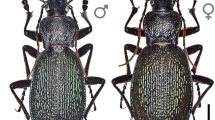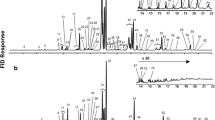Summary
The exocrine glandular secretions of larvae of the subfamily Chrysomelinae are known to repel conspecific adults, other competitive phytophagous insects and natural enemies. InPhaedon cochleariae, the intraspecific activity of tlc fractions of the larval secretion was tested in order to examine the ecological significance of two fractions containing minor components and a fraction containing the major compound, the cyclopentanoid monoterpene (epi)chrysomelidial. InChrysomela lapponica, the defensive activity of the larval secretion against ants is known from specimens feeding upon willow or birch. The feeding preferences of larvae and adults ofC. lapponica from a Finnish and a Czech population were tested. The Finnish individuals significantly preferred feeding uponSalix borealis, whereas they hardly fed upon birch. The Czech specimens clearly preferred birch (Betula pubescens) to willow species. Application of salicin onto leaves of a willow species free of this phenolglycoside revealed that the Finnish individuals preferred feeding upon leaves with salicin. On the other hand, the Czech individuals avoided feeding upon leaves ofB. pubescens treated with salicin. The chemical composition of the glandular secretion of the Finnish larvae differed from the one of the Czech larvae. GC-MS-analyses of the secretions revealed that salicylaldehyde was the only major component of the secretion of Finnish larvae feeding upon the salicin-containing willowS. borealis. The glandular secretion of the Czech larvae feeding upon birch contained numerous esters of isobutyric acid and 2-methylbutyric acid. When Czech larvae had fed upon a salicin-containing willow (S. fragilis), the major compounds of their secretion were benzoic acid, salicylalcohol and benzoic acid esters; salicylaldehyde was only detected in traces. Thus,C. lapponica individuals from the Finland population adapted so closely to a salicincontaining willow that they clearly prefer this plant for food and that they obviously derive their main larval defensive compound (salicylaldehyde) from their host-plant.
Similar content being viewed by others
References
Blum MS (1987) Biosynthesis of arthropod exocrine compounds. Annu Rev Entomol 32:381–413
Blum MS (1994) Antipredatory devices in larvae of the Chrysomelidae: a unified synthesis for defensive eclecticism. Pp 227–288in Jolivet PH, Cox ML, Petitpierre E (eds) Novel Aspects of the Biology of Chrysomelidae. NL-Dordrecht: Kluwer Academic Publ
Blum MS, Brand JM, Wallace JB, Fales HF (1972) Chemical characterization of the defensive secretion of a chrysomelid larva. Life Sci 11:525–531
Brown WM (1956) The new world species ofChrysomela L. (Coleoptera: Chrysomelidae) Can Entomol 88 (Suppl.):3–54
Fitschen J (1994) Gehölzflora (10th ed by Meyer FH, Hecker U, Höster HR, Schroeder F-G). D-Heidelberg: Quelle & Meyer
Hilker M (1989) Intra- and interspecific effects of larval secretions in some chrysomelids (Coleoptera). Entomol exp appl 53:237–245
Hilker M, Schulz S (1994) The composition of the larval secretion ofChrysomela lapponica and its dependence on the host plant. J Chem Ecol 20:1075–1094
Julkunen-Tiitto R (1989) Phenolic constituents ofSalix: a chemotaxonomic survey of further Finnish species. Phytochemistry 28:2115–2125
Kallio P, Mäkinen Y (1975) Vascular flora of Inari Lapland. 3. Salicaceae. Rep Kevo Subarctic Res Stat 12:66–105
Kolehmainen J, Julkunen-Tiitto R, Roininen H, Tahvanainen J (1995) Phenolic glucosides as feeding cues for willow-feeding leaf beetles. Entomol exp appl 74:235–243
Lorenz M, Boland W, Dettner K (1993) Biosynthese von Iridodialen in Wehrdrüsen von Blattkäferlarven (Chrysomelinae). Angew Chemie 105:904–905
Mohr K-H (1966) Chrysomelidae. Pp 95–280in Freude H, Harde KW, Lohse GA (eds) Die Käfer Mitteleuropas. Vol. 9. D-Krefeld: Goecke und Evers
Pasteels JM, Braekman J-C, Daloze D (1982) Chemical defense in chrysomelid larvae and adults. Tetrahedron 38:1891–1897
Pasteels JM, Rowell-Rahier M, Braekman J-C, Dupont A (1983) Salicin from host plant as precursor of salicylaldehyde in defensive secretion of chrysomeline larvae. Physiol Entomol 8:307–314
Pasteels JM, Rowell-Rahier M, Braekman J-C, Daloze D (1984) Chemical defences in leaf beetles and their larvae: the ecological, evolutionary and taxonomic significances. Biochem Syst Ecol 12:395–406
Pasteels JM, Duffey S, Rowell-Rahier M (1990) Toxins in chrysomelid beetles. Possible evolutionary sequence fromde novo synthesis to derivation from food-plant chemicals. J Chem Ecol 16:211–222
Pasteels JM, Rowell-Rahier M, Braekman J-C, Daloze D (1994) Chemical defense of adult leaf beetles updated. Pp 289–302in Jolivet PH, Cox ML, Petitpierre E (eds) Novel Aspects of the Biology of Chrysomelidae. NL-Dordrecht: Kluwer Academic Publ
Rank NE (1992) Host plant preference based on salicylate chemistry in a willow leaf beetle (Chrysomela aeneicollis). Oecologia 90:95–101
Raupp JM, Milan FR, Barbosa P, Leonhardt BA (1986) Methylcyclopentanoid monoterpenes mediate interactions among insect herbivores. Science 232:1408–1410
Rowell-Rahier M, Pasteels JM (1982) The significance of salicin for aSalix-feeder,Phratora (Phyllodecta)vitellinae. Pp 73–79in Visser JH, Minks AK (eds) Proc 5th Int Symp Insect-Plant Relationships. NL-Wageningen: PUDOC
Rowell-Rahier M, Pasteels JM (1986) Economics of chemical defense in Chrysomelinae. J Chem Ecol 12:1189–1203
Soetens Ph, Pasteels JM (1994) Synergistic effect of secondary compounds and nutrients in the host plant choice of a salicaceous-feeding leaf beetle:Phratora vitellinae (Coleoptera: Chrysomelidae). Med Fac Landbouww Univ Gent 59/2b:685–689
Soetens Ph, Rowell-Rahier M, Pasteels JM (1991) Influence of phenolglucosides and trichome density on the distribution of insect herbivores on willows. Entomol exp appl 59:175–187
Tahvanainen J, Julkunen-Tiitto R, Kettunen J (1985) Phenolic glycosides govern the food selection pattern of willow feeding leaf beetles. Oecologia 67:52–56
Thieme H (1971) Vorkommen und Verbreitung von Phenolgylucosiden in der Familie der Salicaceen. Herba Polonica 17:248–257
Zvereva EL, Kozlov MV, Neuvonen S (1995) Decrease of feeding niche breadth ofMelasoma lapponica (Coleoptera: Chrysomelidae) with increase of pollution. Oecologia: in press
Author information
Authors and Affiliations
Rights and permissions
About this article
Cite this article
Gross, J., Hilker, M. Chemoecological studies of the exocrine glandular larval secretions of two chrysomelid species (Coleoptera):Phaedon cochleariae andChrysomela lapponica . Chemoecology 5, 185–189 (1994). https://doi.org/10.1007/BF01240603
Issue Date:
DOI: https://doi.org/10.1007/BF01240603




